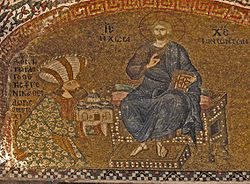- Mesazon
-
Mosaic portraying Theodore Metochites (left), mesazon to Emperor Andronikos II Palaiologos, presenting the model of the renovated Chora Church to Christ Pantocrator.

The mesazōn (Greek: μεσάζων "intermediary", gen.: μεσάζοντος) was a high dignitary and official during the last centuries of the Byzantine Empire, who acted as the chief minister and principal aide of the Emperor.
Contents
History and functions
The term's origins lie in the 10th century, when senior ministers were sometimes referred to as the mesiteuontes (μεσιτεύοντες), i.e. "mediators" between the emperor and his subjects (cf. paradynasteuōn). The title first became official in the mid-11th century, when it was conferred to Constantine Leichoudes, the future patriarch Constantine III.[1] In the Komnenian period, it was awarded to senior government officials who functioned as de facto prime ministers, such as the epi tou kanikleiou and the logothetēs tōn sekretōn, but had not yet acquired a permanent and specific function, nor the power that would characterize it in later years.[1][2] Rather, it was a title bestowed on the principal imperial secretary, who acted precisely as an "intermediary" between the emperor and the other officials.[3][4] This reflected the shift of the Byzantine government under the Komnenoi from the old Roman-style bureaucracy to a more restricted, aristocratic ruling class, where government was exercised within the imperial household, as in feudal Western Europe.[5] The office of mesazōn became formally institutionalized in the Empire of Nicaea,[6] where the holder of the mesastikion (as the function had become known), served as the Empire's chief minister, coordinating the other ministers.[5] As the emperor and historian John Kantakouzenos records, the mesazōn was "needed by the emperor day and night".[1] This arrangement was inherited by the restored Palaiologan Empire and continued in use until the Fall of Constantinople in 1453. The office was also used in the same function in the Byzantine courts of Epirus, Morea and Trebizond. In the latter case, it acquired the epithet megas ("great").[1]
List of mesazontes
- Constantine Leichoudes –1050
- Theodore Styppeiotes, under Manuel I Komnenos
- John Kamateros, under Manuel I Komnenos
- Michael Hagiotheodorites, under Manuel I Komnenos
- Theodore Mavrozomes, under Manuel I Komnenos
- Demetrios Komnenos Tornikes, under John III Vatatzes
- Theodore Mouzalon, –1294
- Nikephoros Choumnos, 1294–1305, under Andronikos II Palaiologos
- Theodore Metochites, 1305–1328, under Andronikos II Palaiologos
- Alexios Apokaukos, 1328–1345, under John V Palaiologos
- Demetrios Kydones, 1347–1354 under John VI Kantakouzenos, 1369–1383 under John V Palaiologos and 1391–1396 under Manuel II Palaiologos
- George Goudelis, late 1390s under Manuel II Palaiologos
- Demetrios Chrysoloras, 1403–1408 in Thessalonica under John VII Palaiologos
- George Doukas Philanthropenos, 1430–1439
- Demetrios Palaiologos Kantakouzenos, 1434/5–1448 under John VIII Palaiologos
- George Doukas Philanthropenos and Markos Palaiologos Iagaris, 1438–1439 while accompanying John VIII Palaiologos to Italy
- Loukas Notaras, 1434–1453, last mesazōn of the Byzantine Empire under John VIII and Constantine XI Palaiologos
References
Sources
- Angold, Michael (1975). A Byzantine government in exile: government and society under the Laskarids of Nicaea, 1204-1261. Oxford University Press. ISBN 978-0198218548
- Bartusis, Mark C. (1997). The Late Byzantine Army: Arms and Society 1204–1453. University of Pennsylvania Press. ISBN 0812216202
- Haldon, John (2009). "The State - 1. Structures and Administration". In Jeffreys, Elizabeth; Haldon, John; Cormack, Robin. The Oxford Handbook of Byzantine Studies. Oxford University Press. ISBN 978-0199252466.
- Kazhdan, Alexander, ed (1991). Oxford Dictionary of Byzantium. Oxford University Press. ISBN 978-0-19-504652-6.
- Magdalino, Paul (2002). The Empire of Manuel I Komnenos, 1143–1180. Cambridge University Press. ISBN 0-521-52653-1.
Categories:- Heads of government
- Byzantine administrative offices
Wikimedia Foundation. 2010.

